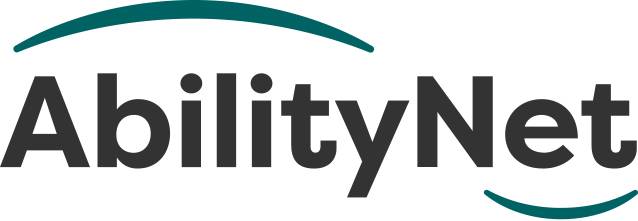
What are Reasonable Adjustments?
This factsheet summarises the steps to support people with an impairment or long-term health condition in work, via reasonable adjustments or accommodations. It also highlights the range of high quality paid for and free services that AbilityNet provides to help disabled people succeed at work.
Employing disabled people is good for business. It can help you to:
- draw on a much broader talent pool
- employ and retain high quality staff who are skilled, loyal and hard working
- improve employee morale and reduce absence through sickness
- create a diverse workforce that more closely reflects your range of customers and the community where you operate
Under the law, there can also be serious penalties for treating someone less favourably because of a personal characteristic, such as being disabled.
Removing physical barriers - lived experience digital disability awareness training
Last updated: March 2024
Contents include
- 1.1. What are Reasonable Adjustments?
- 2.2. What does the law say?
- 3.3. Examples of reasonable adjustments?
- 4.4. How do you know what adjustments are needed?
- 5.5. Why would I need an assessment?
- 6.6. Who decides what is 'reasonable'?
- 7.7. What disabilities are eligible for reasonable adjustments?
- 8.8. Who pays for reasonable adjustments?
- 9.9. How much do they cost?
- 10.10. Is there a grant to cover the costs?
- 11.11. What next?
1. What are Reasonable Adjustments?
Reasonable adjustments at work apply to all workers, including trainees, apprentices, contract workers and business partners. Reasonable adjustments are also referred to as Reasonable accommodations, particularly in the US and Ireland.
Employers are required by law (Equality Act 2010) to make sure workers with disabilities, or physical or mental health conditions, are not substantially disadvantaged when applying or doing their jobs. This means that disabled workers, as far as is reasonable, have the same access to everything involved from application to doing and keeping their job as a non-disabled person.
The employer only has to make adjustments where they are aware – or should be reasonably aware – of a disability.
2. What does the law say?
Under the Equality Act 2010, there is a legal duty on employers to make reasonable adjustments for disabled employees. The Act recognises that solutions may vary according to individual circumstances and offers simple criteria by which any proposed adjustment can be assessed — it must be effective, practical and significant.
3. Examples of reasonable adjustments?
Adjustments are the employer’s responsibility, and will not be particularly expensive. They are not required to do more than is reasonable for them to do.
Examples include:
- Making adjustments to premises
- Allocating some of the disabled person’s duties to another person
- Altering working hours
- Allowing absence for rehabilitation, absence or treatment
- Arranging or giving extra training
- Acquiring or modifying equipment
- Modifying instructions or reference manuals
- Providing a reader or interpreter
- Providing supervision
4. How do you know what adjustments are needed?
The most important lesson is that One Size Does NOT Fit All!
It is not possible to recommend specific solutions for someone with dyslexia, for example, without considering the environment they work in, how much their role relies on their reading or writing, or whether they have related issues such as dyscalculia.
Different people will need different adjustments, even if they appear to have similar impairments. Government guidance on Employing disabled people and people with health conditions includes information on how different specific conditions can affect people. It also gives related examples of potentially helpful adjustments that employers could quite easily make for staff with such impairments.
Making reasonable adjustments is also about understanding the experiences of people living with different disabilities and impairments. This is about two- way communication and training. AbilityNet’s ‘Don’t Disable Me’ training series is led by individuals with lived experience to help explain workplace barriers and solutions.
AbilityNet also has an eLearning option ‘The Accessible Workplace’ which provides the same information in a self-paced package which can also be used as a useful reference guide when supporting others.
5. Why would I need an assessment?
Small changes in the workplace can transform the productivity of any employee, but they can be a complete gamechanger for disabled people. That includes adjustments to work patterns and responsibilities, but can also include tech changes, such as having the right software, using the right screen, or simply changing the size of the font.
AbilityNet can provide a holistic workplace needs assessment so that disabled people can reach their full potential at work. An assessor will discuss barriers experienced at work and make recommendations that could include assistive technology, assistive technology training and other strategies.
Find out more about workplace assessments.
6. Who decides what is 'reasonable'?
Legal precedence does exist to indicate what is considered Reasonable, but this is not set in stone. Most reasonable adjustments can be agreed through communication and discussion. Having an accessibility and disability inclusion policy is helpful. This allows you to define some of the adjustments that people can request.
7. What disabilities are eligible for reasonable adjustments?
AbilityNet supports the ‘social model’ of disability which states that it is the interaction of a person’s disability with the barriers that society puts in place that prevent or hinder people’s access to the built environment, media, transport or education. Change must come from society, not be focused on the individual.
This is a counter to the so-called ‘medical model’ of disability which states that a disability is defined by an individual’s medical condition and it is that condition that affects their ability to carry out tasks. In this model the way to resolve a disability in order to provide equal access is to treat or cure the condition.
The Equality Act is designed to make employers consider that a disabled person is usually made disabled by the environment they are placed in. They have a duty to provide conditions such that all employees can carry out their work.
8. Who pays for reasonable adjustments?
The employer is responsible for paying for any reasonable adjustments. Costs can vary and can be dependent upon the size of the organisation.
9. How much do they cost?
Some adjustments cost nothing
- Every day our Assessors recommend many different adjustments that cost nothing to implement, using existing hardware and software or making simple adjustments to work patterns or responsibilities.
- For example, setting up a mouse for a left-handed person to avoid RSI, or adjusting a spell checker for someone with dyslexia.
- Many of the changes can be found in our free Factsheets or My Computer My Way.
Some cost a few pounds
- Our experts often recommend low-cost options, such as specially adapted mice or keyboards, to help people with physical discomfort.
- For many people a compact keyboard will replace a full-sized keyboard with a numberpad allowing the mouse to be brought in closer and reducing the strain of stretching to use the mouse.
- A trackball or ergonomic mouse can reduce stress on the wrist, which is a common cause of RSI.
Occasionally adjustments cost a few hundred pounds
- Some people do need more expensive solutions, such as adjustable chairs or desks, or specialist software such as Dragon Naturally Speaking.
- Such software often requires training before their benefits can be fully realised.
- That investment is paid back many times over, however, as someone using dictation can typically dictate 5 times faster than the most proficient typist.
10. Is there a grant to cover the costs?
There is money available that may help fund reasonable adjustments. An Access to Work grant is money for practical support to help someone do their job. It’s for people with a disability, health or mental health condition. The money can pay for things like:
- an expert assessment
- specialist equipment
- travel when public transport cannot be used
- a support worker
How much an individual gets will depend on a set of circumstances about them, their other allowances and the size of the employer. It’s only available in England, Scotland and Wales. For more information ask at your local Jobcentre or visit the Access to Work website.
11. What next?
It is advisable to have a standard process at recruitment and onboarding stages to evaluate the needs of the individual to be able to perform at their best. To share the standard adjustments that are available to choose from and to identify anything further that would be helpful.
Most disabled people will have some ideas already about what helps them to perform at their best. They may also appreciate the opportunity to consider other options that could help them.
Tools are available to help you with this. Applicants and employees can fill out a Clear Talents profile which generates an easy-to-use report that can be used by employers to understand the adjustments that are required. If further advice is required, you can tap into the support of expert practitioners such as those found in AbilityNet’s workplace assessment team. They can work with your employee and yourselves to make recommendations for equipment, support and other adjustments that will help.
How AbilityNet can help you
Workplace Services:
AbilityNet can support you in building a workplace that is inclusive by design and uses technology to enable all employees to perform at their best. Learn how to build an inclusive workplace.
Digital Accessibility advice for organisations
AbilityNet's Digital Accessibility Services help ensure your websites, apps and other digital services are accessible, usable and comply with current legislation.
My Computer My Way
My Computer My Way is an AbilityNet run website packed with articles explaining how to use the accessibility features built into your computer, tablet or smartphone. The site is routinely updated as new features and changes are made to the Windows, MacOS, iOS, Chrome OS and Android operating systems. The site is broken down into the following sections:
Vision – computer adjustments to do with vision and colour
Hearing – computer adjustments to do with hearing, communication and speech
Motor – computer adjustments to do mobility, stamina and dexterity
Cognitive – computer adjustments to do with attention, learning and memory
Use My Computer My Way for free
Advice and information
If you have any questions please contact us at AbilityNet and we will do all we can to help.
Call: 0300 180 0028
Please note: calls to our helpline number cost no more than a national rate call to an 01 or 02 number and count towards any inclusive minutes in the same way as 01 and 02 calls, and AbilityNet does not receive any money from these calls.Email: enquiries@abilitynet.org.uk
IT support at home
If you’re looking for in-person support, you can book a free visit from one of our disclosure-checked volunteers. Many of our volunteers are former IT professionals who give their time to help older people and people with disabilities to use technology to achieve their goals. Our friendly volunteers can help with most major computer systems, laptops, tablet devices and smartphones.
Copyright information
This factsheet is licensed by AbilityNet under the Creative Commons Attribution-Non Commercial-ShareAlike 3.0 Unported License. View a copy of this license at creativecommons.org/licenses/by-nc-sa/3.0/




